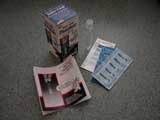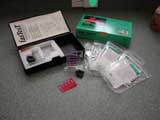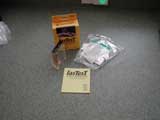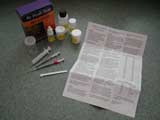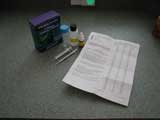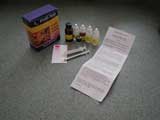Water Test Kits
Overview:
It's very important to know the quality and contents of your aquarium's water and to do so, you'll need to acquire various water test kits. Fortunately, there are a wide variety of test kits types and brands out there to choose from, but what's the difference? Which one should you choose? During my days of water testing, I've used three different types/brands and found a favorite. To help in your research and decision, I've compiled a ton of information about these three types of kits: tablet, powder and liquid.
For each type, I've listed the manufacturer, type of test, how the measurement is taken, the general method for acquiring the measurement and a variety of pros and cons for each kit. I've also highlighted in bold my opinion of the most important pro and con for each.
General comments:
- All of these test kits are fairly easy to use.
- These kits all require small water samples.
- All of these tests must be performed exactly, carefully and following the detailed directions provided with the kit.
- Each of these kits fall in relatively the same price range and most can be purchased as stand-alone tests, or kits containing a wide variety of test types.
- Precision of the individual test depends on the type and manufacturer.
My opinion:
Of anything you'll buy for your tank, test kits are the most personal. However, it's important that they're also as accurate as possible. I recommend that you try out more than one type to find what you're most comfortable with and compare its results with results from tests by other brands. Check out the commentary about water test kits on Usenet for even more opinions. If you ask your LFS (local fish store), make sure you aren't simply being ripped off for the sake of a sale. Sometimes, the same exact product can be ordered for half the price!
Personally, I like to have as precise a measurement as possible and hate to wait 15-20 minutes only to end up staring at color charts, squinting to see which swatch most closely matches my test sample. Therefore, I've found much satisfaction in the Salifert brand.
You may also want to check out other brands like Hach (www.hach.com), La Motte (www.lamotte.com), Kordon (www.kordon.com), Seachem (www.seachem.com) and Hagen (www.hagen.com) as well. Although I have not tried or tested any of these, they are popular products. The Kordon products, specifically, are rumored to be a low-cost copy of the high-quality Hach line.
| Product/Manufacturer |
Type |
Measurement |
Method |
Pros (+) |
Cons (-) |
| Dry-Tab : Aquarium Pharmaceuticals www.aquariumpharm.com |
|
|
Dry, pill-sized tablet. |
Color variations compared to color chart. |
Tablets are added to a small water sample, shaken to dissolve and the resulting color is compared to a color chart for measurement.
See a test step by step. |
* Comes in single test and kit form.
* Safest form of test.
|
* Color variations to compare by are very similar and must be compared under specific lighting conditions, making reading difficult.
* Tablets can be mildly hazardous.
* Can take up to six minutes for tablets to dissolve.
* Some tests require long wait periods.
* All chemicals have expiration date.
* Color charts fade over time (expire).
* Small number of tests per single test kit.
|
| |
|
|
|
|
|
| Product/Manufacturer |
Type |
Measurement |
Method |
Pros (+) |
Cons (-) |
| FasTest and SeaTest : Aquarium Systems www.aquariumsystems.com |
|
|
Dry, powder. |
Color variations compared to color chart. |
Powders are added to a small water sample, shaken to dissolve and the resulting color is compared to a calibrated color bar.
See a test step by step. |
* Comes in single test and kit form.
* Powders dissolve rapidly.
* Fairly safe form of testing.
|
* Color variations to compare by are very similar and must be compared under specific lighting conditions, making reading difficult.
* Powders can be mildly hazardous.
* Some tests require long wait periods.
* All chemicals have expiration date.
* Color charts fade over time (expire).
* Rectangular test-tubes (second photo left) leak when shaking them.
|
| |
|
|
|
|
|
| Product/Manufacturer |
Type |
Measurement |
Method |
Pros (+) |
Cons (-) |
| Profi-Test : Salifert www.salifert.com |
|
|
Liquid or combination of liquid and powders. |
Reading metric scale on syringe and comparing to chart (or using formula). Some by color variation to color chart. |
Various chemicals are added to a small, 4ml sample of water. A reagent is usually added drop wise via a syringe until a specific color change is noted in the sample (i.e. from blue to red). The reading on the metric scale on the syringe is noted and the measurement is taken from a chart provided.
See a test step by step. |
* Very precise.
* Extremely fast test yield results in seconds to a couple minutes.
* Some kits perform more than one type of test (i.e. Strontium AND Calcium)
* Tests with color variations have wide differences between colors (see photo left)
|
* Chemicals can be hazardous.
* Must be performed carefully and accurately.
* Some chemicals have expiration dates.
* Color charts fade over time (expire).
|
Sample Tests:
I've included below snapshots from tests being performed with each of the test kits. Please note that these are only provided for demonstration purposes, and you should follow the instructions that came with your individual test kit.
Dry-Tab (Aquarium Pharmaceuticals) Sample Test For Phosphate
NOTE: Please follow the instructions that came with your individual test kit. This sample test is provided for demonstration purposes only. |
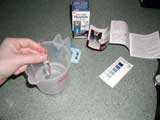 |
1. Test tube is rinsed and filled with water to be tested. |
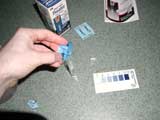 |
2. Chemical tablets are added to the test tube (2 in this case). |
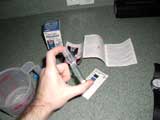 |
3. Shake until tablets dissolve. In this particular case, two tablets can take five minutes of shaking to dissolve fully. Your arm gets tired after a while. |
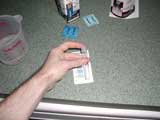 |
4. Take reading by comparing sample color to included color chart in natural or white fluorescent lighting. In this case, zero color equals zero phosphates. |
| |
|
FasTest/SeaTest Sample Test For pH
NOTE: Please follow the instructions that came with your individual test kit. This sample test is provided for demonstration purposes only. |
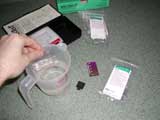 |
1. Rinse and fill test tube with water to be sampled. |
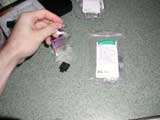 |
2. Add powder chemical to sample. In FasTest's pH test, only one powder is required. |
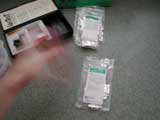 |
3. Shake to dissolve. Because of the powder form, test chemical dissolves quickly. |
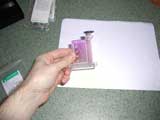 |
4. Insert calibrated color bars and compare with color of test sample against white background in natural or white fluorescent lighting. In this test, pH was approximately 8.1 (color seemingly appears between 8.0 and 8.2). |
| |
|
Salifert Profi-Test Sample Test For Strontium/Calcium
NOTE: Please follow the instructions that came with your individual test kit. This sample test is provided for demonstration purposes only. |
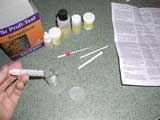 |
1. Add 4ml of water to be tested into test tube using supplied 5ml syringe. |
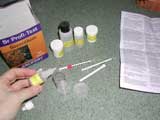 |
2. Add specific number of drops of first chemical to test sample. |
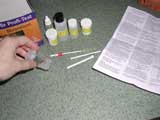 |
3. Swirl for a second or two. |
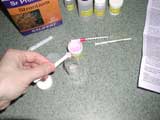 |
4. Add level scoop of powder (pink) to test sample. |
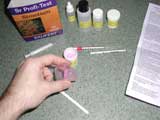 |
5. Swirl to dissolve. Color of sample is pink. |
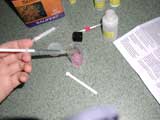 |
6. Add next chemical one drop at a time. |
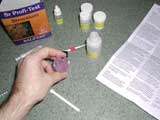 |
7. Swirling in between each drop. |
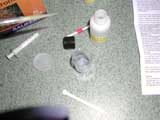 |
8. Until color changes (to blue in this case). |
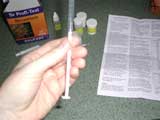 |
9. In this case, the reading on the syringe, when compared to a chart, will give us the calcium content of the sample. |
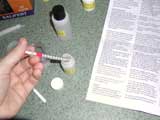 |
10. To get the strontium measurement, we continue with the sample, adding chemical 1. |
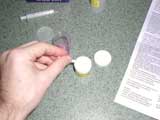 |
11. And adding another powder and swirling to dissolve. |
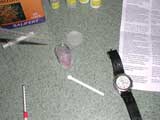 |
12. Finally we add our reagent again drop by drop, swirling between each drop until... |
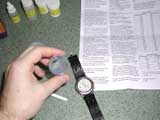 |
13. The sample changes color. |
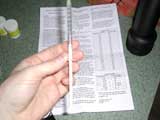 |
14. The measurement on the syringe gives us the strontium content when compared to the included chart (or using a formula). |
|
|
